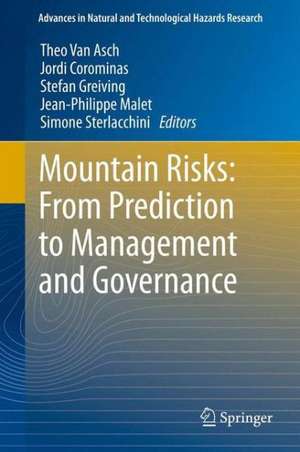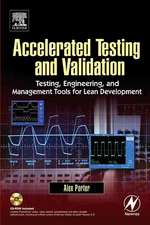Mountain Risks: From Prediction to Management and Governance: Advances in Natural and Technological Hazards Research, cartea 34
Editat de Theo Van Asch, Jordi Corominas, Stefan Greiving, Jean-Philippe Malet, Simone Sterlacchinien Limba Engleză Hardback – 13 noi 2013
The first part of the book focuses on new techniques for assessing the natural hazards of different types of mass movements. State-of-the-art techniques for morphological characterization and monitoring of displacements are described. Computational advances are covered to explain the process systems and to quantify the hazards of fast and slow-moving landslides.
In the second part of the book methodologies are included for assessing the impact of these natural hazards on the society in terms of risks. In this part, methodologies for defining the vulnerability of the elements at risk are shown and the use of run-out models for risk assessment of the dangerous rapid mass movements are evaluated.
The third part of the book focuses on the response of society towards the problems of hazard and risk. It highlights the role of spatial planning, early warning systems and evacuation plans for risk management. It establishes practical thresholds for acceptable and tolerable risks and emphasizes the importance of education and communication to society.
Audience
The book is of interest to a wide range of experts from related disciplines, practitioners and stakeholders to demonstrate the importance of an integrated approach for all aspects of risks in mountainous areas.
| Toate formatele și edițiile | Preț | Express |
|---|---|---|
| Paperback (1) | 571.73 lei 38-44 zile | |
| SPRINGER NETHERLANDS – 18 sep 2016 | 571.73 lei 38-44 zile | |
| Hardback (1) | 651.51 lei 6-8 săpt. | |
| SPRINGER NETHERLANDS – 13 noi 2013 | 651.51 lei 6-8 săpt. |
Din seria Advances in Natural and Technological Hazards Research
- 18%
 Preț: 977.97 lei
Preț: 977.97 lei - 18%
 Preț: 921.15 lei
Preț: 921.15 lei - 18%
 Preț: 1406.35 lei
Preț: 1406.35 lei - 18%
 Preț: 788.72 lei
Preț: 788.72 lei - 15%
 Preț: 643.84 lei
Preț: 643.84 lei - 18%
 Preț: 955.56 lei
Preț: 955.56 lei - 18%
 Preț: 954.31 lei
Preț: 954.31 lei - 18%
 Preț: 958.56 lei
Preț: 958.56 lei - 18%
 Preț: 937.56 lei
Preț: 937.56 lei - 18%
 Preț: 952.72 lei
Preț: 952.72 lei -
 Preț: 382.18 lei
Preț: 382.18 lei - 15%
 Preț: 647.92 lei
Preț: 647.92 lei - 18%
 Preț: 948.47 lei
Preț: 948.47 lei - 15%
 Preț: 640.06 lei
Preț: 640.06 lei -
 Preț: 407.01 lei
Preț: 407.01 lei - 15%
![Submarine Mass Movements and Their Consequences [With CDROM]](https://i4.books-express.ro/bs/9781402012440/submarine-mass-movements-and-their-consequences-with-cdrom.jpg) Preț: 604.37 lei
Preț: 604.37 lei - 15%
 Preț: 643.48 lei
Preț: 643.48 lei - 15%
 Preț: 648.05 lei
Preț: 648.05 lei - 18%
 Preț: 1236.99 lei
Preț: 1236.99 lei - 18%
 Preț: 947.35 lei
Preț: 947.35 lei - 18%
 Preț: 947.35 lei
Preț: 947.35 lei - 18%
 Preț: 966.15 lei
Preț: 966.15 lei - 15%
 Preț: 642.51 lei
Preț: 642.51 lei - 18%
 Preț: 951.29 lei
Preț: 951.29 lei - 18%
 Preț: 1255.16 lei
Preț: 1255.16 lei - 15%
 Preț: 642.51 lei
Preț: 642.51 lei - 15%
 Preț: 646.43 lei
Preț: 646.43 lei - 15%
 Preț: 635.96 lei
Preț: 635.96 lei - 18%
 Preț: 1244.08 lei
Preț: 1244.08 lei
Preț: 651.51 lei
Preț vechi: 766.49 lei
-15% Nou
Puncte Express: 977
Preț estimativ în valută:
124.71€ • 135.50$ • 104.82£
124.71€ • 135.50$ • 104.82£
Carte tipărită la comandă
Livrare economică 21 aprilie-05 mai
Preluare comenzi: 021 569.72.76
Specificații
ISBN-13: 9789400767683
ISBN-10: 9400767684
Pagini: 276
Ilustrații: XI, 413 p. 143 illus., 108 illus. in color.
Dimensiuni: 155 x 235 x 25 mm
Greutate: 0.73 kg
Ediția:2014
Editura: SPRINGER NETHERLANDS
Colecția Springer
Seria Advances in Natural and Technological Hazards Research
Locul publicării:Dordrecht, Netherlands
ISBN-10: 9400767684
Pagini: 276
Ilustrații: XI, 413 p. 143 illus., 108 illus. in color.
Dimensiuni: 155 x 235 x 25 mm
Greutate: 0.73 kg
Ediția:2014
Editura: SPRINGER NETHERLANDS
Colecția Springer
Seria Advances in Natural and Technological Hazards Research
Locul publicării:Dordrecht, Netherlands
Public țintă
ResearchCuprins
Preface.- 1. Introduction: The components of risk governance.- Part I : New techniques for assessing mass movement hazards.- 2. Innovative techniques for the detection and characterization of the kinematics of slow-moving landslides.- 3. Innovative techniques for the characterization of the morphology, geometry and hydrological features of slow-moving landslides.- 4. Techniques for the modelling of the process systems in slow and fast-moving landslides.- Part II: Methodologies to assess the impact of the natural hazards on the society in terms of risks.- 5. Methods for debris flow hazard and risk assessment.- 6. Advances in methodologies for rockfall hazard and risk assessments.- 7. Medium-scale multi-hazard risk assessment of gravitational processes.- 8. Methods for the characterization of the vulnerability of elements at risk.- 9. The importance of the lessons learnt from past disasters for risk assessment.- Part III: The response of the Society towards the problems of hazard and risk.- 10. Disaster mitigation by spatial planning.- 11. Disaster mitigation by corrective and protection measures.- 12. The relevance of legal aspects, risk cultures and insurance possibilities for risk management.- 13. The relevance of Early-Warning Systems and evacuation plans for risk management.- 14. Risk assessment: Establishing practical thresholds for acceptable and tolerable risks.- 15. The use of geo-information and modern visualization tools for risk communication.- Index.
Recenzii
“This is a very interesting and useful volume that represents an important contribution to the field. … the book integrates both natural and social sciences and provides useful reviews of the state of the art in a wide variety of areas of risk assessment and management. … chapters that examine different aspects of risk assessment are very valuable and deserve to be widely read. It will be of interest to both the research and the practitioner communities.” (David Petley, Mountain Research and Development, Vol. 35 (2), May, 2015)
Textul de pe ultima copertă
This book offers a cross disciplinary treatment of the rapidly growing field of integrated approaches in risk assessment in mountainous areas. All major aspects related to hazard and risk assessment, risk management, and governance are illustrated with a wide range of case studies.
The first part of the book focuses on new techniques for assessing the natural hazards of different types of mass movements. State-of-the-art techniques for morphological characterization and monitoring of displacements are described. Computational advances are covered to explain the process systems and to quantify the hazards of fast and slow-moving landslides.
In the second part of the book methodologies are included for assessing the impact of these natural hazards on the society in terms of risks. In this part, methodologies for defining the vulnerability of the elements at risk are shown and the use of run-out models for risk assessment of the dangerous rapid mass movements are evaluated.
The third part of the book focuses on the response of society towards the problems of hazard and risk. It highlights the role of spatial planning, early warning systems and evacuation plans for risk management. It establishes practical thresholds for acceptable and tolerable risks and emphasizes the importance of education and communication to society.
Audience
The book is of interest to a wide range of experts from related disciplines, practitioners and stakeholders to demonstrate the importance of an integrated approach for all aspects of risks in mountainous areas.
The first part of the book focuses on new techniques for assessing the natural hazards of different types of mass movements. State-of-the-art techniques for morphological characterization and monitoring of displacements are described. Computational advances are covered to explain the process systems and to quantify the hazards of fast and slow-moving landslides.
In the second part of the book methodologies are included for assessing the impact of these natural hazards on the society in terms of risks. In this part, methodologies for defining the vulnerability of the elements at risk are shown and the use of run-out models for risk assessment of the dangerous rapid mass movements are evaluated.
The third part of the book focuses on the response of society towards the problems of hazard and risk. It highlights the role of spatial planning, early warning systems and evacuation plans for risk management. It establishes practical thresholds for acceptable and tolerable risks and emphasizes the importance of education and communication to society.
Audience
The book is of interest to a wide range of experts from related disciplines, practitioners and stakeholders to demonstrate the importance of an integrated approach for all aspects of risks in mountainous areas.
Caracteristici
Interdisciplinary approach covering all aspects of mountain hazard and risk assessment, management and governance Describes state-of-the-art methodological and computational advances, as well as new risk management strategies for quantitative hazard and risk analysis Gives an advanced understanding of mountain hydro-geomorphological processes and on how to apply this understanding to living with hazards in the long-term Includes supplementary material: sn.pub/extras







